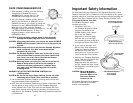
P re s s u re Cooking
Operating Instru c t i o n s
1. Position the electrical cord in the slot located on the bottom of
the Pressure Cooker.
2. Prepare food according to recipe or
chart. If recipe calls for sautéing
vegetables or browning meat, add oil
to the Pressure Cooker Pan and turn
the Variable Temperature Pressure
Control to MAX/BROWNING, 7, 8, or 9.
The Russell Hobbs® Pressure Cooker
has a Browning Feature that allows
you to sauté or brown foods in the
Pressure Cooking Pan before cooking under pressure. (Follow
the procedures described in the Features: Browning section
of this manual.)
3. Follow recipe or chart directions; remove the browned food
and/or add the the other ingredients. Always use 1-3 cups of
water, broth, wine, fruit or vegetable juice, or other liquid for
pressure cooking. Do not use milk, milk products, or cream
sauces, as they tend to scorch easily. Make sure the rim of the
Pan is clean and dry. Never beat a spoon or other utensil on the
rim of the Pressure Cooker Pan. Any dent or mar in the rim may
prevent a good seal from forming and prevent the Pressure
Cooker from pressurizing properly.
4. Place the clean Gasket in position inside the Pressure Cooker
Lid, make sure it is under Lid Lock Mechanism and the Steam
Vent inside the rim of the Lid.
5. Place Lid onto the top of the Pressure Cooker Pan so that the
Lid Handle is slightly to the right of the Pressure Cooker Pan
Handle. Turn the Lid Handle clockwise until the two Handles are
together and facing you. The Lid Lock Button locks the Lid in
place. Make sure the Lid is properly
seated on the rim of the Pressure
Cooker Pan and is securely attached
onto the Pan.
6. Turn the Pressure Regulator Valve on
top of the Lid to PRESSURE.
11
7. Turn the Variable Temperature/Pressure Control to WARMING.
8. Plug the unit into a 120V AC wall outlet. The POWER Indicator
Light will illuminate.
9. Turn the Variable Temperature/
Pressure Control to MAX/BROWNING.
CAUTION: NEVER LEAVE YOUR PRESSURE
COOKER UNATTENDED AT A
HIGH HEAT SETTING.
10. As soon as the pressure starts to build, however slight, the Pressure
Lift Pin will jiggle until it reaches full pressure and locks the Lid onto
the Pressure Cooker Pan. Do not try to remove the Lid until the
pressure has been safely released. Wait for a gentle steady flow of
steam to be released from the Pressure Regulator Valve accom-
panied by a loud hiss: the Pressure Cooker is now at full pressure.
11. Begin timing once the high pressure is reached. Follow the recipe
or Cooking Guide, allow food to cook for time specified.
NOTE: The amount of food being cooked will determine
how long it takes to bring the Pressure Cooker
up to full pressure.
12. Quickly turn the Variable Temperature/
Pressure Control to 6 to 7 (see illustration)
until you hear a constant hissing sound
that will fluctuate as the pressure changes.
Experience will teach you what setting on
your Pressure Cooker to use to maintain
the proper pressure.
IMPORTANT: If the heat is too high, there is a constant very loud
hissing. You MUST turn the heat down. TOO MUCH HEAT
CAN RESULT IN EXCESSIVE LOSS OF COOKING LIQUID.
13. When the food has cooked under proper pressure for the required
length of time, turn the Variable Temperature/Pressure Control to
WARMING and unplug the unit. The POWER Indicator Light will
turn off.
14. Release pressure using either the Natural Steam Release or Quick
Steam Release Feature, following the procedures described in the
Steam Release Methods section of this manual.
NOTE: Cooking times listed in this book are only guidelines.
Personal preferences vary; adjust cooking times
accordingly.
CAUTION: Always use the Cool Touch Handles to move the Pressure
Cooker Pan.
12
Operating Instructions ( C o n t i n u e d )


















